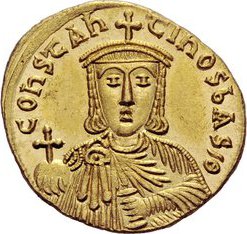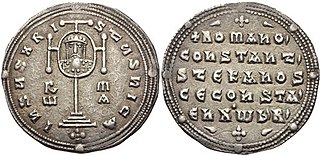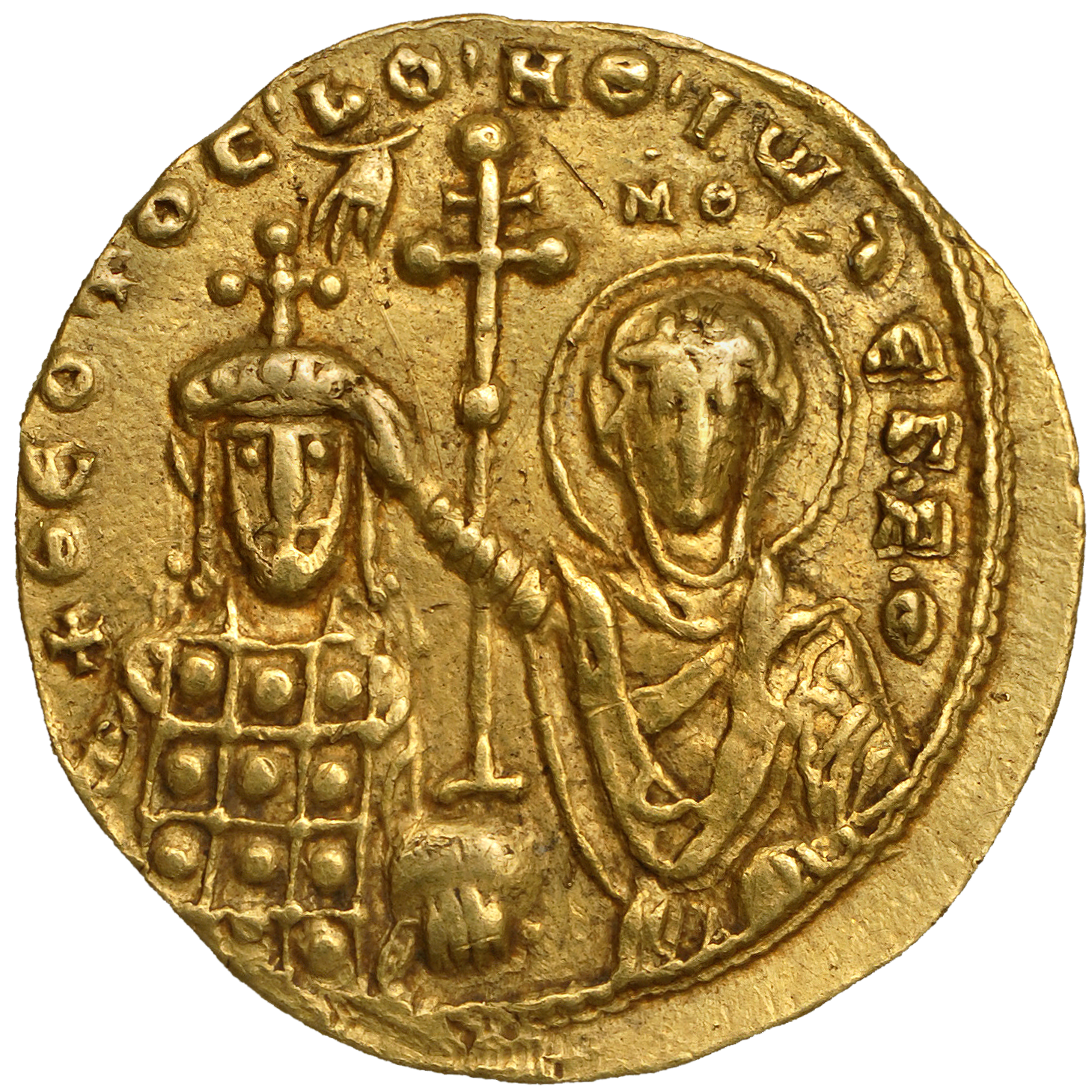 W
WIsaac II Angelos was Byzantine Emperor from 1185 to 1195, and again from 1203 to 1204.
 W
WBasil II Porphyrogenitus, nicknamed the Bulgar Slayer, was the senior Byzantine Emperor for almost 50 years, having been a junior colleague to other emperors since 960. He and his brother Constantine were named as co-rulers before their father Romanos II died in 963. The throne went to two generals, Nikephoros Phokas then John Tzimiskes, before Basil became senior emperor. His influential great-uncle Basil Lekapenos was the de facto ruler of the Byzantine Empire until 985. Basil II then held power for forty years.
 W
WConstantine IV, called the Younger and sometimes incorrectly Pogonatos out of confusion with his father, was Byzantine Emperor from 668 to 685. His reign saw the first serious check to nearly 50 years of uninterrupted Islamic expansion, while his calling of the Sixth Ecumenical Council saw the end of the monothelitism controversy in the Byzantine Empire; for this, he is venerated as a saint in the Eastern Orthodox Church, with his feast day on September 3.
 W
WConstantine V was Byzantine emperor from 741 to 775. His reign saw a consolidation of Byzantine security from external threats. As an able military leader, Constantine took advantage of civil war in the Muslim world to make limited offensives on the Arab frontier. With this eastern frontier secure, he undertook repeated campaigns against the Bulgars in the Balkans. His military activity, and policy of settling Christian populations from the Arab frontier in Thrace, made Byzantium's hold on its Balkan territories more secure.
 W
WConstantine VI was Byzantine emperor from 780 to 797. The only child of Emperor Leo IV, Constantine was named co-emperor with him at the age of five in 776 and succeeded him as sole Emperor in 780, aged nine. His mother Irene exercised control over him as regent until 790, assisted by her chief minister Staurakios. The regency ended when Constantine reached maturity, but Irene sought to continue her participation in government. After a few years of sole rule Constantine named his mother Empress in 792, making her his official colleague.
 W
WTheodore Komnenos Doukas was ruler of Epirus and Thessaly from 1215 to 1230 and of Thessalonica and most of Macedonia and western Thrace from 1224 to 1230. He was also the power behind the rule of his sons John and Demetrios over Thessalonica in 1237–1246.
 W
WJoannicius the Great was a Byzantine Christian saint, sage, theologian and prophet. Well-known for his devoted asceticism and defense of icon veneration, Joannicius spent the majority of his life as a hermit on Mount Uludağ, near what is today Bursa, Turkey. Joannicius lived during the reign of Emperor Theophilos, a noted iconoclast, which contrasted with Joannicius's embrace of icon veneration. Icon veneration was later restored to the Byzantine Empire under the reign of Empress Theodora, a move that some devotees ascribe to Joannicius's influence and prophecies. Joannicius served in the Byzantine army in his early years before devoting his life to ascetic study and monastic contemplation. He is venerated with a feast day on November 4 in the Eastern Orthodox Church and Roman Catholic Church.
 W
WTheodore II Doukas Laskaris or Ducas Lascaris was Emperor of Nicaea from 1254 to 1258. He was the only child of Emperor John III Doukas Vatatzes and Empress Irene Laskarina. His mother was the eldest daughter of Theodore I Laskaris who had established the Empire of Nicaea as a successor state to the Byzantine Empire in Asia Minor, after the crusaders captured the Byzantine capital, Constantinople, during the Fourth Crusade in 1204. Theodore received an excellent education from two renowned scholars, Nikephoros Blemmydes and George Akropolites. He made friends with young intellectuals, especially with a page of low birth, George Mouzalon. Theodore began to write treatises on theological, historical and philosophical themes in his youth.
 W
WThe Martyrs of Adrianople, also known and venerated as the 377 Martyred Companions in Bulgaria, were three hundred and seventy seven Christians who were executed in martyrdom in 815. They are commemorated by the Eastern Orthodox Church on 22 January.
 W
WMichael I Rangabe was Byzantine emperor from 811 to 813.
 W
WMichael IV the Paphlagonian was Byzantine Emperor from 11 April 1034 to his death on 10 December 1041.
 W
WMichael VIII Palaiologos or Palaeologus reigned as the co-emperor of the Empire of Nicaea from 1259 to 1261, and as Byzantine emperor from 1261 until his death. Michael VIII was the founder of the Palaiologan dynasty that would rule the Byzantine Empire until the Fall of Constantinople in 1453. He recovered Constantinople from the Latin Empire in 1261 and transformed the Empire of Nicaea into a restored Byzantine Empire.
 W
WNikephoros I or Nicephorus I was Byzantine emperor from 802 to 811, when he was killed in the Battle of Pliska. Prior to his accession, he had served as genikos logothetēs, whence he is sometimes surnamed "the Logothete" and "Genikos" or "Genicus".
 W
WNikephoros II Phokas, Latinized Nicephorus II Phocas, was Byzantine emperor from 963 to 969. His brilliant military exploits contributed to the resurgence of the Byzantine Empire during the 10th century. His reign, however, included controversy. In the west, he inflamed conflict with the Bulgarians and saw Sicily completely turn over to the Muslims, while he failed to make any serious gains in Italy following the incursions of Otto I. Meanwhile, in the east, he completed the conquest of Cilicia and even retook the islands of Crete and Cyprus, thus opening the path for subsequent Byzantine incursions reaching as far as Upper Mesopotamia and the Levant. His administrative policy was less successful, as in order to finance these wars he increased taxes both on the people and on the church, while maintaining unpopular theological positions and alienating many of his most powerful allies. These included his nephew John Tzimiskes, who would take the throne after killing Nikephoros in his sleep.
 W
WMichael IX Palaiologos or Palaeologus, was Byzantine Emperor together with his father Andronikos II Palaiologos from 1294 until his death.
 W
WRomanos I Lekapenos, Latinized as Romanus I Lecapenus, was a Byzantine naval commander who became Byzantine emperor and reigned from December 919 until his deposition on December 944.
 W
WAshot Taronites was a Byzantine nobleman. Captured by the Bulgarians in 995, he was released in 996 and married to Miroslava, daughter of Tsar Samuel of Bulgaria. Appointed governor of Dyrrhachium by Samuel, he and his wife fled to Constantinople and arranged for Dyrrhachium to be handed over to Byzantine rule.
 W
WGregory Taronites was an Armenian prince of Taron, who went over to Byzantine service and held senior commands and governorships under Emperor Basil II. He was killed by the Bulgarians at an ambush near Thessalonica ca. 991 or 995.
 W
WJohn I Tzimiskes was the senior Byzantine Emperor from 11 December 969 to 10 January 976. An intuitive and successful general, he strengthened the Empire and expanded its borders during his short reign.
 W
WBasil Vatatzes was a Byzantine military commander, and likely the father of the Nicaean emperor John III Doukas Vatatzes.